Last Friday, I met with Donna Morrissey, Canadian author of a quartet of novels set in Newfoundland, where she grew up and lived for many years, although she now resides in Halifax. We discussed a piece of writing I’d submitted for mentorship (I was thrilled because she thought it beautiful, moving, and publishable with only minor editing) and chatted about the mix of truth and fabrication in her novels. As vibrant as her writing, Donna told me her characters are inspired by real people, but of course appear different and take on traits and personalities of their own during the writing process. The colourful outport village dialogue she writes is patterned on the spoken word in her home village of The Beaches. When I asked if Kit’s Law (her first novel) had required much revision after it was accepted, she threw up her hands. “Oh, yes! I’d written it with all this Newfoundland jargon they couldn’t understand.”

Houses in Channel-Port-aux Basques (© Magi Nams)
Vilis and I traveled to Newfoundland for the first time this year, arriving at Channel-Port-aux Basques on the island’s southwest tip on June 24 after a seven-hour ferry trip from North Sydney, Nova Scotia. As the ferry chugged into port, we understood immediately why Newfoundland’s nickname is ‘The Rock.’ The port town clung to rolling bedrock, with gravestones rearing up from pockets of soil here and there among rock ridges. Simple, box-like houses crammed twisting streetsides, and blue-flag irises bloomed in boggy depressions at the edge of town. In rain and wind, Vilis and I walked the streets and among the gravestones, struck by the landscape’s harshness and rugged beauty, and the poignancy of those gravestones. Thus began our two-week exploration of Newfoundland, which I’ll chronicle in today’s and six upcoming posts.

Blue-flag Iris (© Magi Nams)
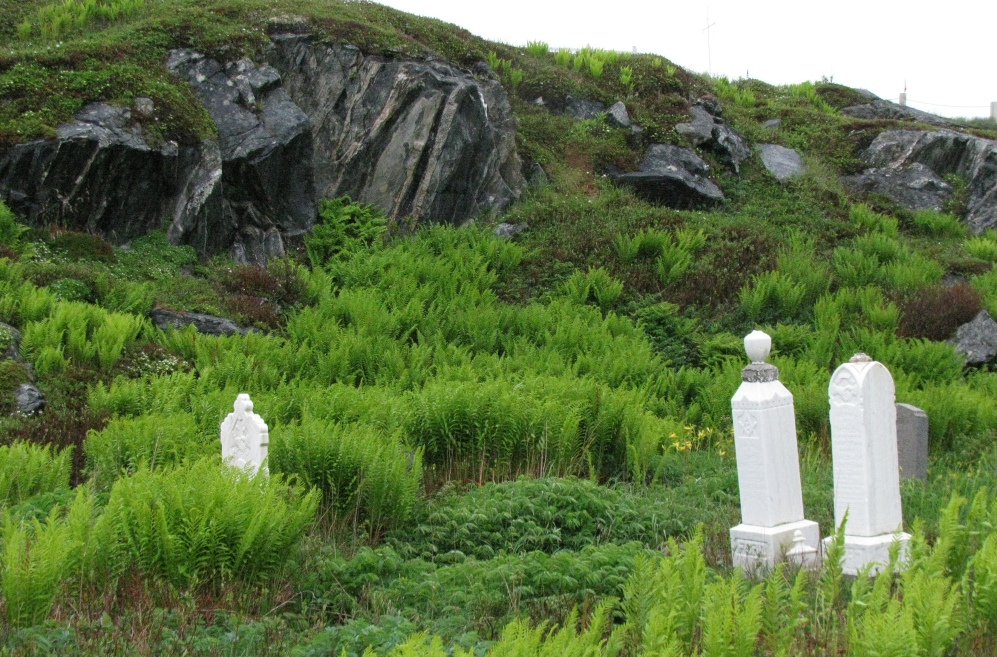
Gravestones in Channel-Port-aux Basques (© Magi Nams)
.
The next morning, we drove northwest, leaving the south coast’s rain for the brooding clouds and gentler agricultural landscape of the Codroy Valley and its small farms. We hiked the Codroy Valley Wetlands Trail, spotting a ruffed grouse, American goldfinches, a suite of wood warblers and other songbirds, and a pair of ospreys winging high over the wetland. Green frogs twanged out their rubber-band songs. Farther northwest, toward Codroy, a small flock of thickly-woolled sheep grazed in a roadside pasture.

Codroy Valley, Newfoundland (© Magi Nams)
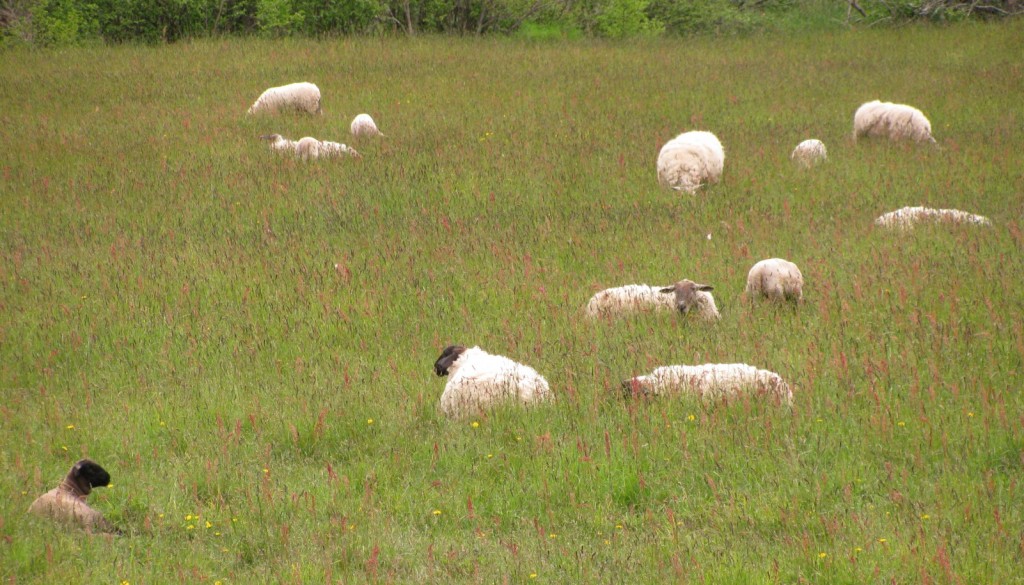
Sheep in Codroy Valley (© Magi Nams)
Enticed by the rolling scenery and long views, we drove a coastal road to the fishing village of Codroy and strolled through a graveyard looking out onto the Gulf of St. Lawrence, with the imposing Holy Trinity Anglican Church beside us.
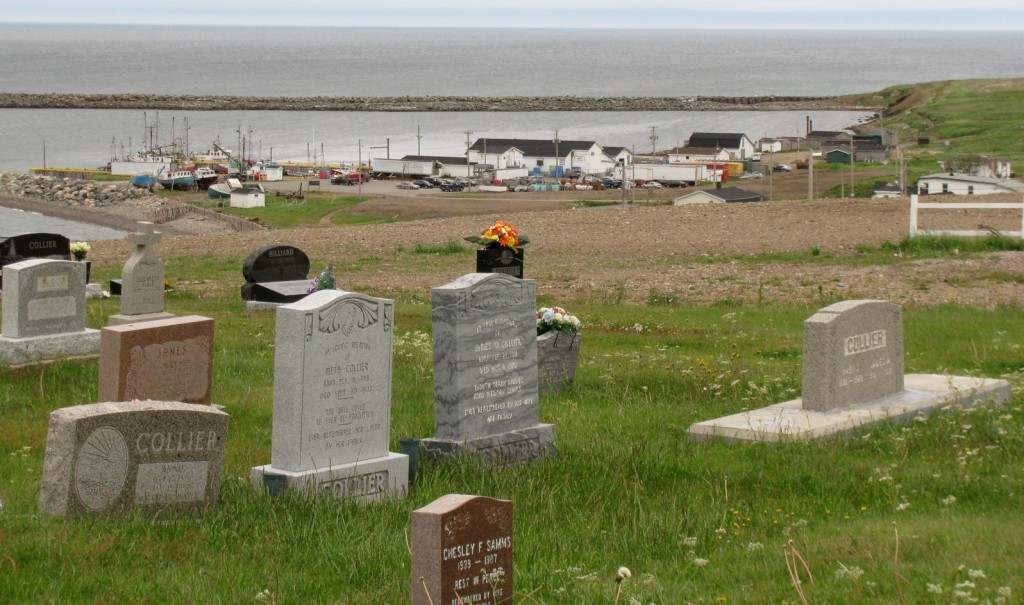
Codroy, Newfoundland (© Magi Nams)
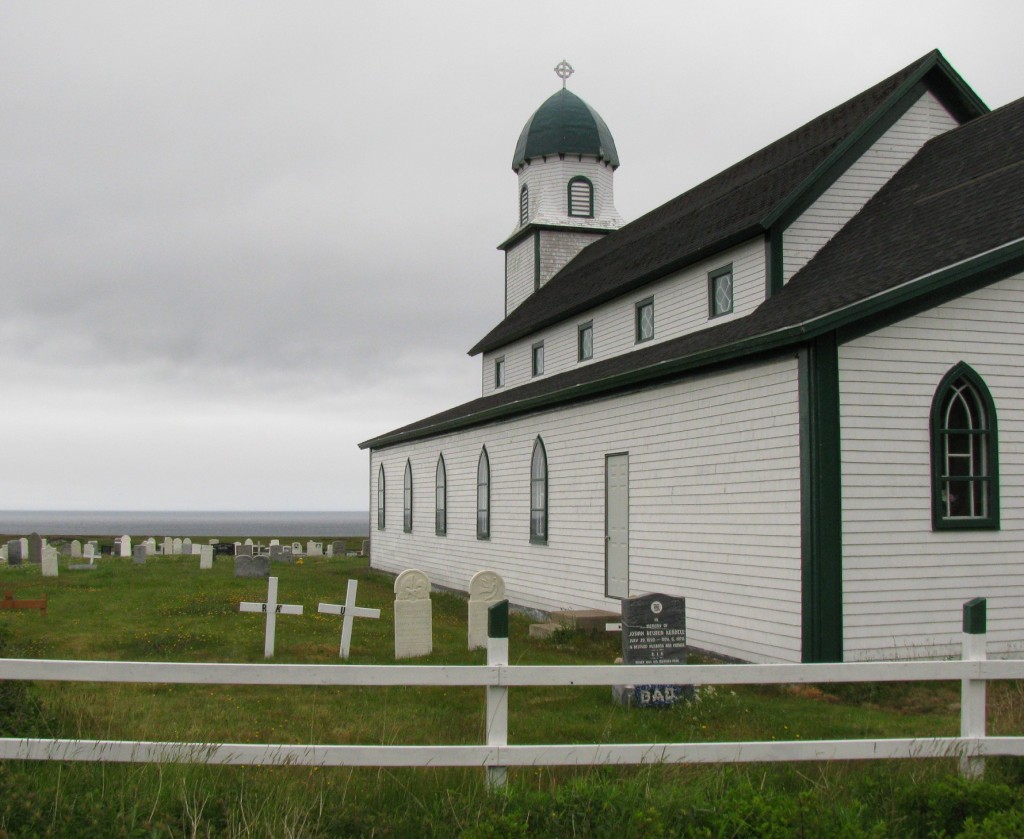
Holy Trinity Anglican Church, Codroy (© Magi Nams)
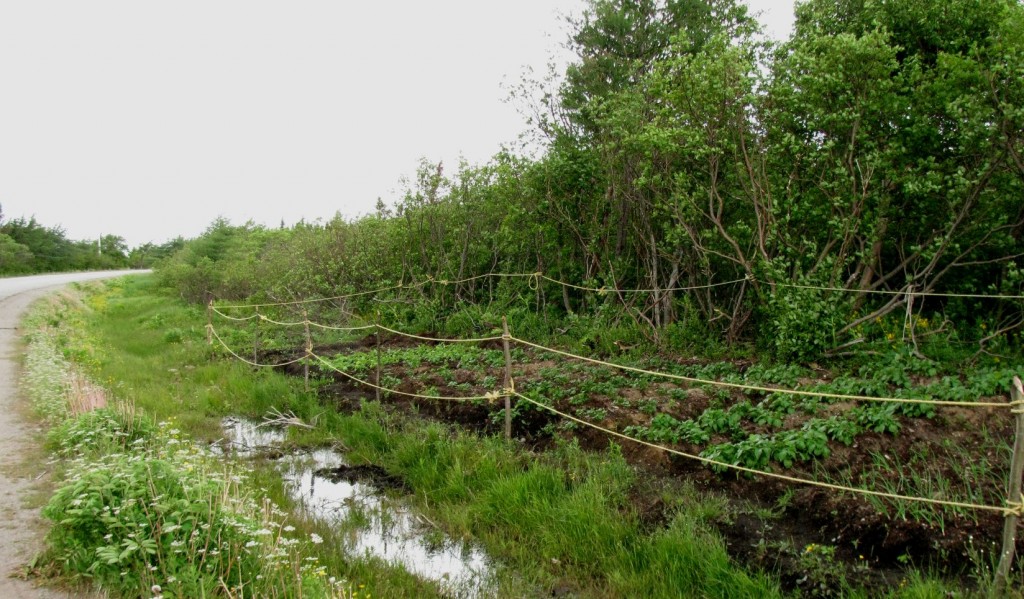
Newfoundland Roadside Garden (© Magi Nams)
During our drive, we’d spotted roadside piles of firewood with sleds and snowmobiles beside them, and roadside gardens planted in patches of good soil, with no house in sight. Newfoundland has so much rock and so little arable land that its residents take advantage of any bit of potential garden space available. Most frequently, roadside gardens were filled with potato plants, but we also noticed onions and cabbages.
We drove beyond Codroy to the grazed hills and rocky shores of Cape Anguille, Newfoundland’s westernmost point, where we strolled around Cape Anguille Lightstation and hiked an old dirt road beside the shore. I spotted great black-backed gulls and ring-billed gulls in a large pond near the lightstation, and numerous savannah sparrows voicing their ‘che-che-che-CHEE-aye’ songs from atop shrubs and grasses in open meadows.
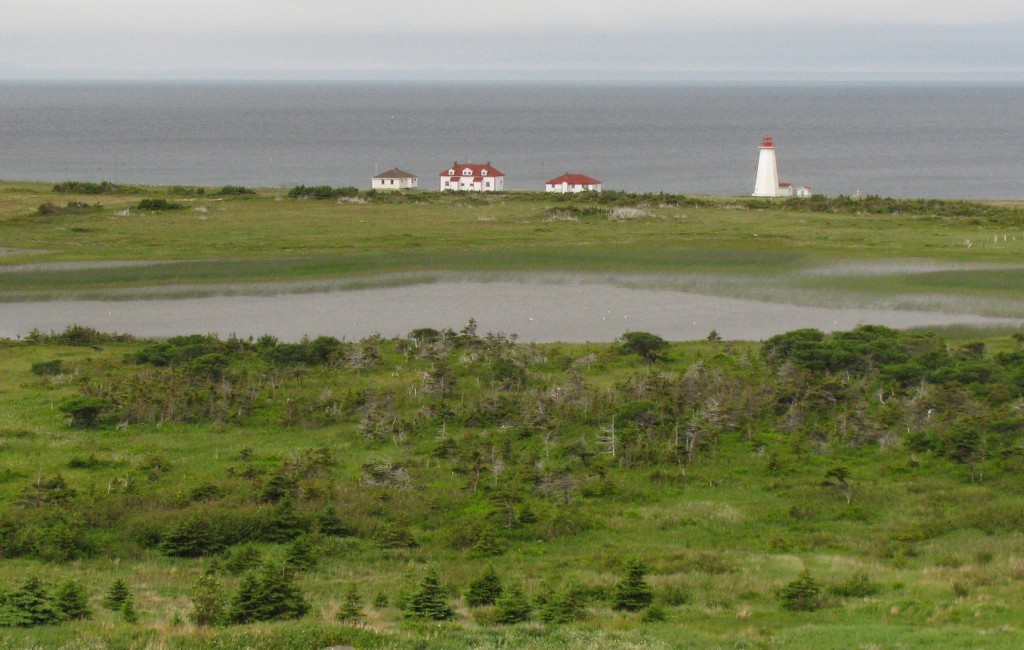
Cape Anguille Lightstation and Lighthouse Inn, Newfoundland (© Magi Nams)
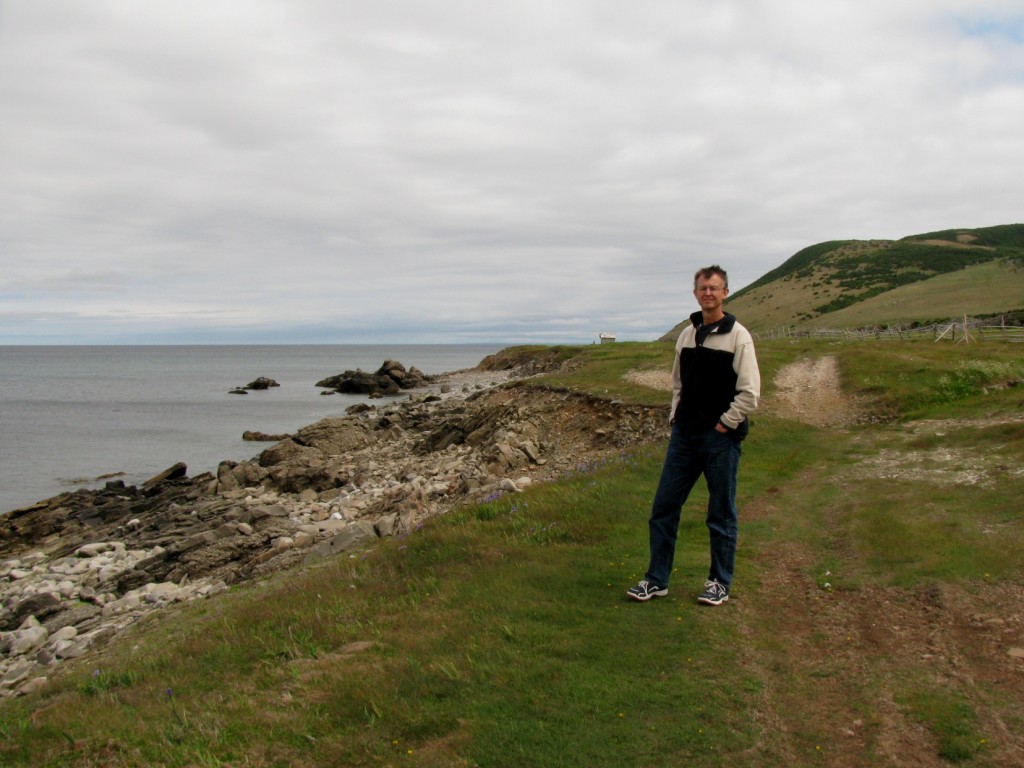
Vilis at Cape Anguille, Newfoundland (© Magi Nams)
We bought fries from a chip wagon in Codroy, then returned to the TransCanada Highway and angled northeast between the coastal Anguille Mountains to the west and the brooding Long Range Mountains to the east. Cloud spilled down into forested valleys, and uplands closed in around us near Corner Brook. Also near that small university city (reminded me of Moncton, New Brunswick) we saw our first gravel pit campers. Parking trailers in gravel pits and hanging out is a popular form of Newfoundland recreation. For a humourous take on gravel pit camping, check out the song and video by the Newfoundland band Buddy Wasisname and the Other Fellers (http://www.youtube.com/watch?v=qCz5adDDOAw ).
Beyond Corner Brook, we drove through gorges bounded by sheer-sided hills having bare rock cliffs, the rugged terrain a taste of what was to come in Gros Morne National Park, our hiking and camping destination for the next several days. At Deer Lake, we drove north into the national park and to a campground near Trout River, a small fishing community just outside the park. A bull moose trotted across the road in front of us in early evening. Amazingly, it was the only moose we saw during our two weeks in Newfoundland. The Rock is overrun with moose, which are an introduced species. They cause hundreds of vehicle accidents every year.
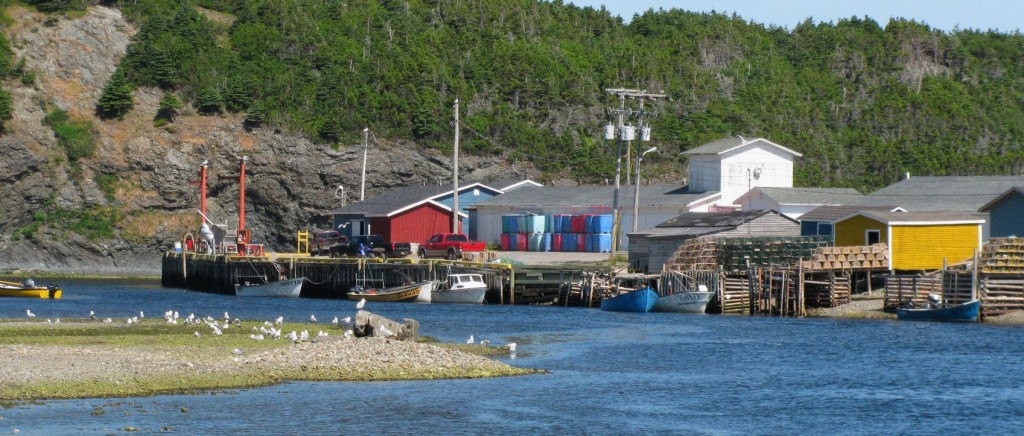
Trout River, Newfoundland (© Magi Nams)

Socks for Sale, Trout River, Newfoundland (© Magi Nams)
Small and tidy, Trout River obviously caters to the influx of visitors to the national park next door. Home knitting hung from clotheslines, the brightly-coloured socks and mittens dancing in the summer breeze. I bought a pair of wool socks from Patsy for the price of $10. She told me she passes time in winter knitting, and that it takes her a day to knit a pair of socks. Her husband is a fisherman, who on that day was fishing for halibut, his boat one of a number out in the bay. The fishers I saw were all older men, the younger generation perhaps making their fortunes in Alberta’s oilfields.
We hiked Eastern Point Trail from Trout River’s sandy crescent beach up onto grassy uplands edged with plunging cliffs and headlands. Irises and other wildflowers splashed colour alongside the trail, which led us past empty pastures high above the beach and offered us spectacular views out over a western Newfoundland fishing port and the rugged ridges and ocean cradling it.
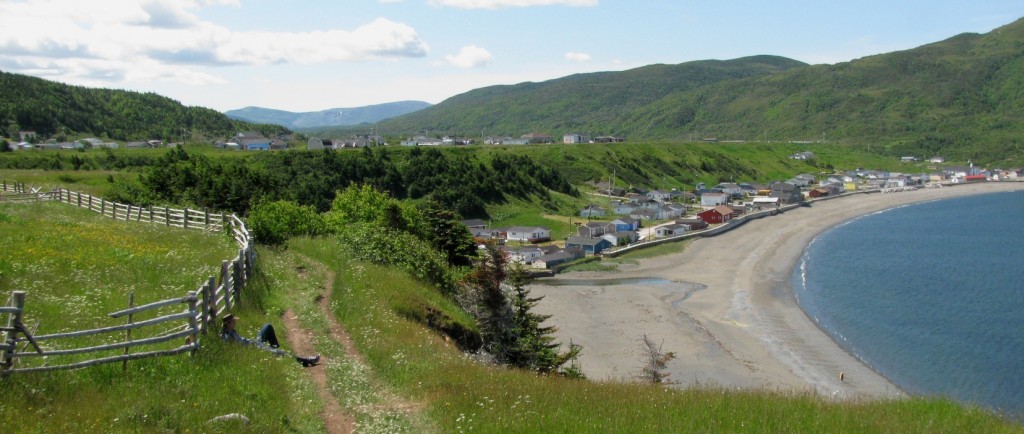
Vilis beside Eastern Point Trail above Trout River, Newfoundland (© Magi Nams)



Oh, wow, Magi, this is all so beautiful. Feel like I was tagging along with you. Thanks for sharing!
Hi, Bev! Thanks for visiting my site. Newfoundland is truly a place unto itself – so beautiful and rugged, with amazingly friendly people. Vilis and I really enjoyed our time there, our eyes finally opened to this spectacular corner of Canada.
Magi
Magi, we honeymooned on The Rock. It was around the first of November nearly 20 years ago, grey and chilly and it was marvelous. We took the ferry, like you, and stayed a few nights in Deer Lake to start our trip. Then we did several hiking trails in Gros Morne, which I think is one of most stunning places I’ve ever visited.
Loved your post. LOVED IT.
Thanks for dropping by, Donna! You’re absolutely right. Gros Morne is amazing. It’s undoubtedly one of Canada’s scenic wonders, and I’d recommend it to any traveler to The Rock. My next post will feature the park front and centre. Can’t wait!
Magi
Hi, Magi . I was looking up the rocks at the Tablelands at Trout River… and there you are!
Looks like you had a good visit.
I just bought a rock polisher, sorting out my pebbles. So many -I can look up the labelled ones!
Did you get to Flowers Cove? I haven’t finished reading your blog.
Hi Monica,
Great to hear from you! No, I didn’t get to Flowers Cove, but we had a super time on the Rock. The Tablelands are magnificent, as are many of Newfoundland’s other landscapes. Thanks for visiting my blog!